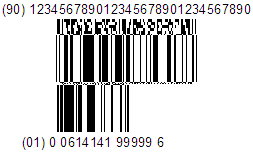 Linear Symbologies
Linear Symbologies
A linear symbology is a single row of bars and spaces. The elements can vary either by width (such as UPC-8, illustrated below) or by height (such as Royal Mail 4-State, illustrated below):
|
|
|
|






